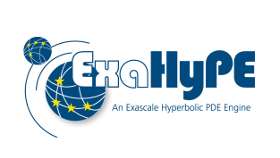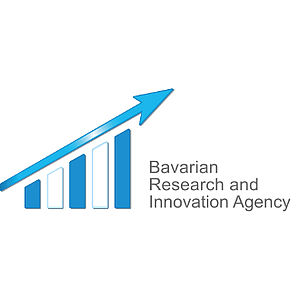
ExaHyPE

The supercomputers of tomorrow need new software
Computer-based simulations drive progress in the field of science. In addition to theory and experiments, simulations have long since been crucial for acquiring knowledge and insight. Supercomputers allow for the computation of increasingly complex and precise models. A billion billion, i.e. 1018 computer operations per second (1 exaflop/s) is the level of performance that the next generation of supercomputers should be able to deliver. In order to be able to leverage the incredible processing power of exascale systems for correspondingly comprehensive simulation tasks, the entire supercomputing infrastructure, including the software, must be prepared for such systems. However, programming such supercomputers is a challenge. In October 2015, the European Commission began funding ‘’ExaHyPE’’ („An Exascale Hyperbolic PDE Engine“), an international project coordinated at the Technische Universität München, which seeks to establish the algorithmic foundations for exascale supercomputers in the next four years. The aim is to develop novel software, initially for simulations in geophysics and astrophysics, which will be published as open-source software for further use.
Project Overview
Project aims and fields of work
Currently, the biggest obstacle for achieving exascale computing is energy consumption. Today, the world's fastest supercomputers operate in the petaflop/s range (1015 computer operations per second) and require between 8 and 18 megawatts, with the energy costs amounting to about US$ 1 million per megawatt and year. That is why simulation software developed as part of the ExaHyPE project will be consistently designed for the requirements of future energy-efficient hardware.
On the hardware side, an extreme parallelization is to be expected. By 2020, supercomputers will encompass hundreds of millions processor cores. At the same time, the hardware – which is pushed to its physical limits to achieve the further increase in performance and still must run as energy efficiently as possible – will increasingly tend to be plagued with interruptions and fluctuating performance curves. ExaHyPE will consequently examine the dynamic distribution of computer operations to processor cores – even if these fail while performing calculations.
Another objective is to reduce the internal-hardware communication simultaneously with the parallelization. Each data transfer is implemented at the expense of energy consumption. In ten years, supercomputers will be able to run calculations 1000 times faster than today. However, memory access time will fail to evolve at the same rate. The used algorithms should be inherently memory-efficient and require as little data transfer as possible to ensure fast, energy-efficient computer operations.
In order to take full advantage of the smallest possible amount of memory, the consortium is developing new scalable algorithms, which dynamically increase the resolution of simulations, i.e. the implemented numerical observation points, wherever the computer simulation needs – and only there. As a result, scientists will be able to limit the necessary computer operations to a minimum while simultaneously achieving the greatest possible accuracy for the simulation.
Target group
The project results will address researchers in diverse disciplines who work with complex simulations, from those in academia to those in industry. Another focus is set on supercomputing stakeholders.
The ExaHyPE researchers will prepare the new algorithms based on two application scenarios taken from geophysics (earthquakes) and astrophysics (gamma ray explosions). In spite of the two precisely defined areas of application, the researchers want to keep the new algorithms as general as possible so that they may also be used in other disciplines after making corresponding adaptations. Examples could include the simulation of climate and weather phenomena, the complex flow and combustion processes in engineering sciences, or even the forecasting of natural catastrophes like tsunamis or floods.
The objective is to ensure that medium-size, interdisciplinary research teams are able to adapt the simulation software for their specific purposes within a year of its release. To guarantee a rapid dissemination of the new technology, the consortium will release it as open source software.
BayFOR as partner
The Bavarian Research Alliance supported the ExaHyPE consortium in applying for funding. It contributed to the “Implementation“ chapter and proofread the “Impact“ chapter. Further, BayFOR calculated the budget and assisted in preparing the grant with the European Commission.
During the project course, BayFOR manages the project administratively. Besides, it leads the work package for disseminating and communicating the scientific findings.
Funding period
ExaHyPE is funded by the European Commission under Horizon 2020, the Framework Programme for Research and Innovation. The grant totals EUR 2.8 million, 1.3 million of which is designated for Bavarian partners. The project began on 1st October, 2015, and will end on 30th September, 2019.
Consortium
The ExaHyPE project has an interdisciplinary team of researchers from seven institutions in Germany, Italy, the United Kingdom, and Russia and is coordinated by Prof. Dr. Michael Bader, Informatics Department, Technische Universität München.
Technische Universität München, Germany
Università degli Studi di Trento, Italy
Durham University, United Kingdom
Frankfurt Institute for Advanced Studies, Germany
Ludwig-Maximilians-Universität München, Germany
ZAO „RSC Technologies“, Russia
Bavarian Research Alliance, Germany
Associated partner
Leibniz Supercomputing Centre, Germany
Further information
Project website
Press release for project commencement
Your contacts at BayFOR

Dipl.-Geogr./M. A. Gudrun Lampart
Coordination Funding Programme (BayIntAn)
Phone: +49 89 9901888-190
Email: internationalisierung@no-spam-pleasebayfor.org




